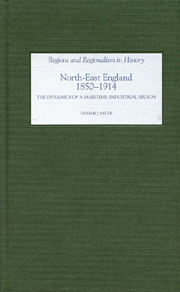Book contents
- Frontmatter
- Contents
- Dedication
- List of illustrations
- Preface
- 1 The North East in time and space
- 2 Horizons: ports, trade and mobility
- 3 Hinterlands and industrial districts
- 4 Making and managing the maritime landscape
- 5 Cohesion and diversity in the maritime urban system
- 6 The horizons of North East shipowning
- 7 Business and the maritime-industrial complex
- 8 Conclusion
- Sources and bibliography
- Index
3 - Hinterlands and industrial districts
Published online by Cambridge University Press: 12 September 2012
- Frontmatter
- Contents
- Dedication
- List of illustrations
- Preface
- 1 The North East in time and space
- 2 Horizons: ports, trade and mobility
- 3 Hinterlands and industrial districts
- 4 Making and managing the maritime landscape
- 5 Cohesion and diversity in the maritime urban system
- 6 The horizons of North East shipowning
- 7 Business and the maritime-industrial complex
- 8 Conclusion
- Sources and bibliography
- Index
Summary
Ports are Janus-faced, looking outward to the wider maritime forelands that were the subject of Chapter 2, and also back into their hinterlands. In the North East, those hinterlands were complicated spaces, comprising the sprawling coalfield and a range of commodity-trading networks and manufacturing centres, and pulled together by an extensive railway network. Most strikingly from the external perspective, the hinterlands of the various North East ports encompassed one of England's most distinctive industrial areas – by the later nineteenth century this had become the great stereotype of a coal, shipping and heavy-metal industrial district, standing in contrast not only to the agrarian shires, but also to other clusters of industrialisation, such as the textile-manufacturing North West, or the light-engineering Midlands. Attempts to define the North East, both contemporary and historiographical, are heavily influenced by those staple industries, as commentators work to locate it within wider processes of trade and industry; this was as much the case in the sudden growth of the economy from the mid-nineteenth to the early twentieth century, as in its equally dramatic collapse subsequently.
Historians have done a great deal of research on the regional basis of industrial development in recent years, demonstrating that the industrialisation of Europe was driven by intense, localised clusters of activity, and exploring why only some places became industrial districts, how they worked, and how they developed over time. Many of these explanations relate to the availability of natural resources, labour forces, entrepreneurial drive and capital, while others focus on the dynamics of business networks and the competitive and/or collaborative characteristics of firms working in close proximity.
- Type
- Chapter
- Information
- North East England, 1850–1914The Dynamics of a Maritime-Industrial Region, pp. 51 - 79Publisher: Boydell & BrewerPrint publication year: 2006



